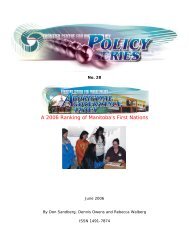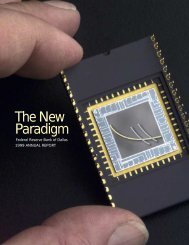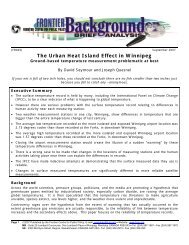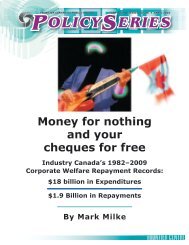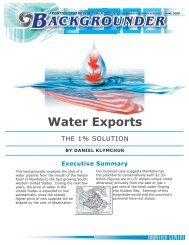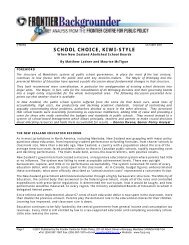The New Paradigm - Federal Reserve Bank of Dallas
You also want an ePaper? Increase the reach of your titles
YUMPU automatically turns print PDFs into web optimized ePapers that Google loves.
42<br />
Effective April 26, 1999, FRBNY was given sole authorization by the FOMC to lend<br />
U.S. government securities held in the SOMA to U.S. government securities dealers<br />
and to banks participating in U.S. government securities clearing arrangements, in<br />
order to facilitate the effective functioning <strong>of</strong> the domestic securities market. <strong>The</strong>se<br />
securities-lending transactions are fully collateralized by other U.S. government securities.<br />
FOMC policy requires FRBNY to take possession <strong>of</strong> collateral in amounts in<br />
excess <strong>of</strong> the market values <strong>of</strong> the securities loaned. <strong>The</strong> market values <strong>of</strong> the collateral<br />
and the securities loaned are monitored by FRBNY on a daily basis, with additional<br />
collateral obtained as necessary. <strong>The</strong> securities loaned continue to be accounted<br />
for in the SOMA. Prior to April 26, 1999, all <strong>Reserve</strong> <strong>Bank</strong>s were authorized to engage<br />
in such lending activity.<br />
Foreign exchange contracts are contractual agreements between two parties to exchange<br />
specified currencies at a specified price on a specified date. Spot foreign contracts<br />
normally settle two days after the trade date, whereas the settlement date on<br />
forward contracts is negotiated between the contracting parties, but will extend<br />
beyond two days from the trade date. <strong>The</strong> FRBNY generally enters into spot contracts,<br />
with any forward contracts generally limited to the second leg <strong>of</strong> a swap/warehousing<br />
transaction.<br />
<strong>The</strong> FRBNY, on behalf <strong>of</strong> the <strong>Reserve</strong> <strong>Bank</strong>s, maintains renewable, short-term F/X<br />
swap arrangements with authorized foreign central banks. <strong>The</strong> parties agree to<br />
exchange their currencies up to a prearranged maximum amount and for an agreedupon<br />
period <strong>of</strong> time (up to 12 months) at an agreed-upon interest rate. <strong>The</strong>se arrangements<br />
give the FOMC temporary access to foreign currencies that it may need for<br />
intervention operations to support the dollar and give the partner foreign central bank<br />
temporary access to dollars it may need to support its own currency. Drawings under<br />
the F/X swap arrangements can be initiated by either the FRBNY or the partner foreign<br />
central bank, and must be agreed to by the drawee. <strong>The</strong> F/X swaps are structured<br />
so that the party initiating the transaction (the drawer) bears the exchange rate<br />
risk upon maturity. <strong>The</strong> FRBNY will generally invest the foreign currency received<br />
under an F/X swap in interest-bearing instruments.<br />
Warehousing is an arrangement under which the FOMC agrees to exchange, at the<br />
request <strong>of</strong> the Treasury, U.S. dollars for foreign currencies held by the Treasury or<br />
ESF over a limited period <strong>of</strong> time. <strong>The</strong> purpose <strong>of</strong> the warehousing facility is to supplement<br />
the U.S. dollar resources <strong>of</strong> the Treasury and ESF for financing purchases <strong>of</strong><br />
foreign currencies and related international operations.<br />
In connection with its foreign currency activities, the FRBNY, on behalf <strong>of</strong> the <strong>Reserve</strong><br />
<strong>Bank</strong>s, may enter into contracts that contain varying degrees <strong>of</strong> <strong>of</strong>f-balance sheet market<br />
risk, because they represent contractual commitments involving future settlement,<br />
and counterparty credit risk. <strong>The</strong> FRBNY controls credit risk by obtaining credit<br />
approvals, establishing transaction limits, and performing daily monitoring procedures.<br />
While the application <strong>of</strong> current market prices to the securities currently held in the<br />
SOMA portfolio and investments denominated in foreign currencies may result in values<br />
substantially above or below their carrying values, these unrealized changes in<br />
value would have no direct effect on the quantity <strong>of</strong> reserves available to the banking<br />
system or on the prospects for future <strong>Reserve</strong> <strong>Bank</strong> earnings or capital. Both the<br />
domestic and foreign components <strong>of</strong> the SOMA portfolio from time to time involve<br />
transactions that can result in gains or losses when holdings are sold prior to maturity.<br />
However, decisions regarding the securities and foreign currencies transactions,<br />
including their purchase and sale, are motivated by monetary policy objectives rather<br />
than pr<strong>of</strong>it. Accordingly, earnings and any gains or losses resulting from the sale <strong>of</strong><br />
such currencies and securities are incidental to the open market operations and do not<br />
motivate its activities or policy decisions.<br />
1999 ANNUAL REPORT <strong>Federal</strong> <strong>Reserve</strong> <strong>Bank</strong> <strong>of</strong> <strong>Dallas</strong>




